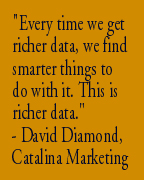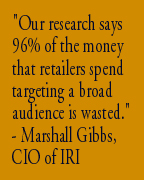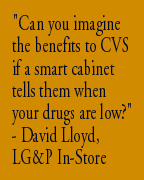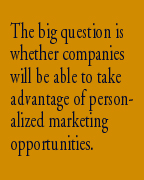Feb. 24, 2003 – You stand in line at the supermarket checkout counter, flipping through a tabloid newspaper, waiting for the checkout person to find out how much the plum tomatoes are per pound. When cashier finally rings you up, he hands you a receipt with a coupon printed on the back. You toss the coupon in one of the bags and forget about it.
The problem with marketing in general and in-store marketing in particular is that it tends to be scattershot before consumers buy and targeted only after they make purchases, which makes it grossly inefficient. Radio frequency identification has the potential to radically change the equation and enable retailers and manufacturers to market to customers while they are shopping, when decisions can still be influenced. RFID may also provide unique insights into consumer behavior at the shelf. And eventually, it may take consumer marketing into the home.
In this Special Report Low-Cost RFID: The Way Forward, we have focused on the short-, medium-, and long-term changes that RFID will force upon companies. Although the first tagged products will begin to appear in stores next year, the real impact of RFID on the marketing department won’t begin to be felt for several years, when most of the items in stores have RFID tags.
Nevertheless, the potential benefits of RFID-driven marketing are so great that we believe smart retailers will begin exploring the potential today. The challenges are also great. They involve not just deploying infrastructure in stores and managing complex databases, but also linking marketing and supply chain functions. In effect, companies will not only have to link IT systems back through the supply chain to suppliers, but forward to the shelf, the customer in the store and even the customer’s home.
The earliest marketing benefits of RFID, in fact, will relate to the supply chain visibility that RFID tagging will create. A study by the Grocery Manufacturers of America (GMA) finds that supermarkets are out of stock on promotional items 20 percent of the time. One in five customers responding to a promotion doesn’t get the product. That results in lost sales and unhappy customers.
Within a year or two, some large manufacturers like Procter & Gamble and The Gillette Co. will coordinate RFID tracking of pallets and cases with large retailers like Wal-Mart, Target and Tesco. Both the retailer and the manufacturer will have visibility back through the supply chain. If a promotion leads to greater than expected sales, the partners can add extra shipments or redirect shipments from other areas to ensure product is available. The retailer might curtail the promotion if it sees its partners can’t deliver enough stock to meet the demand.
Beyond this simple benefit, it’s hard to draw any solid conclusions about how RFID will be used in marketing because the infrastructure doesn’t exist yet. But we can tell you how leading companies are envisioning using the technology, once the majority of items in stores are tagged.
Initially, checkout counters will be equipped with dual RFID-bar code readers. And there will likely be a few displays in stores with high-value items that will have readers built into the shelves. Among the items that might be tagged are razors and batteries in supermarkets, CDs and computer games in mass merchandise stores, and over-the-counter drugs in pharmacies.
“The first thing manufacturers want to know is location of the purchase,” says Marshall Gibbs, CIO of market research firm Information Resources, Inc. (IRI). “If I’m Pepsi, I want to know whether you picked up that bottle from the soft drink aisle, or from the promotional display in the season aisle, because I want to understand how my merchandising of the shelves is driving your purchasing decisions.”
The first smart displays will also let manufacturers know whether retailers are sticking to agreements to keep the display out for a certain period of time. Beyond that, they will also let manufacturers know whether RFID provides a significant sales lift if the displays can be kept permanently stocked. If there is a clear benefit — and almost everyone believes there will be — then manufacturers will likely work with retailers to install antennas on certain shelves.
The first smart shelves will likely be used for fast-moving consumer goods that are often out of stock. If the shelves provide a return on investment from reducing out of stocks, they will likely proliferate through the store and more and more individual items will get RFID tags.
It’s not clear exactly what data will be stored on the tags, beyond a serial number, or what information in a database will be related to that serial number. Most marketing experts expect there will be more point-of-sale data than can currently be gleaned from a bar code.
“No one has figured all this out yet,” says David Diamond, president of emerging businesses and chief vision officer at Catalina Marketing, a St. Petersburg, Florida, company that provides targeted marketing services to manufacturers and retailers. “But we know that every time we get richer data, we figure smarter things to do with it. This is definitely going to be richer data.”
Having smart shelves will enable manufacturer and retailers to begin doing more sophisticated price elasticity testing. Today, they can test the results of promotions simply by analyzing sales. What they can’t judge is consumer interest. When there are RFID readers on shelves, it becomes perfectly feasible to test interest in an item at different prices. The readers could be set up to monitor how many customers picked up an item and put it back. It may even be possible for third parties like Catalina Marketing to gain insights into how discounts affect behavior versus a competitor’s product on a nearby shelf.
“I would love to be able to know someone looked at [a product] and didn’t buy at this price but did take it at that price,” says Diamond. “That will be doable, and it will be great data. It will be used in tests as opposed to on an ongoing basis.”
The real benefit of RFID in the store is to be able to market to individual consumers. That’s been the dream of marketers since forever because they know that broadcast advertising is inefficient and wasteful. “We did studies that showed the actual purchase population that makes up 80 percent of the revenue for a couple of major brands is less than four percent,” says IRI’s Gibbs. “That tells retailers that 96 percent of the money they spend on a broad audience is wasted. They need more targeted programs.”
There are a lot of companies doing a lot of tests on a lot of different devices right now to see which is most suitable for one-to-one marketing. Some are looking at pitching consumers burgers on a cell phone as they drive towards a McDonald’s. Others are looking at PDAs and other devices. Marketing may well be done on these devices outside of the store, but in the store, the right sales tool is a no-brainer: The shopping cart.
Imagine a cart equipped with an RFID reader that can scan a tag on each item you put inside. Mounted on the handle bar is a small display linked wirelessly to a local area network. Each time you put an item into the cart, the reader picks up the ID and the display shows the item and the price. But it does more. It begins displaying advertisements for items related to those you’ve already purchased.
“You pick up a salad, I talk to you about salad dressing,” says Diamond. “You pick up peanut butter, I talk to you about jelly. I can do your meal planning for you on the fly in the store, which is a very powerful notion.”
The small shopping cart computer could display a running total of your purchases. That alone could increase sales, since many people make sure they don’t spend more than they have in their wallets. It also gives stores the opportunity to sell more. Let’s say you’ve purchased $42.30 worth of goods, and you pass a reader on your way to the checkout line. It picks up a signal from your cart, and suddenly your cart displays this message: “If you purchase $50 worth of goods today, you qualify for a 5 percent discount” or “. . .you earn 100 frequent flyer miles.”
If a store provides a loyalty card, the marketing can be more personalized. You swipe your card by the reader on the cart (or through the mag-stripe reader built into the cart’s computer) and now your cart knows you personally. It can track what you put in, and what you later took out and decided not to buy. It can gather a wealth of information on your shopping habits, the way cookies tracking your interests on the Web.
If the store’s database shows that you usually purchase a case of beer once a month, but haven’t purchased any beer in five weeks. The computer on the cart gets that information from a database wirelessly, and the screen tells you that you can get a discount if you buy two cases of beer today. Or it offers you a special deal on a competitor’s beer. The key is that the store is now able to influence the consumer’s purchasing decisions when they are being made.
Catalina’s Diamond believes that we will eventually move toward not just personalized marketing, but personalized pricing. “It’s absolutely achievable,” he says. “It simply says that you understand who the consumers are and what their habits are, and based on that, you are prepared to make them just a good enough deal to keep them in your store. It will take some time, and some consumers won’t like it.”
Here’s how it might work. You swipe your loyalty card through the terminal on your cart. The retailer’s database shows that you have never purchased sirloin steaks when they are more than $2.99 per pound. As you approach the meat counter, you see the steaks are $3.29 per pound today. You begin to move on, but the terminal on your cart knows you are by the meat counter and that the steaks haven’t been moving this week. You get a message: “Mr. Smith, because you are a valued customer, we are offering you sirloin steaks today for $2.99 per pound.” When you put the steak into your cart, the new price is written to the RFID tag.
This may sound a little farfetched, but the technology already exists to do these things. The biggest question is when will the hardware costs get low enough to make it feasible — that is, when will system prices fall to a level where the retailer gets a return on investment. It’s hard to say how quickly that will happen. To some extent it will depend on demand and innovation in the marketplace, but most experts are predicting these systems will begin to be deployed in five to ten years.
Looking even further out, there is the potential to take marketing into the home. “Can you imaging the benefits to CVS or drug manufacturers if a smart cabinet in your bathroom could tell them when your drugs are low or when you haven’t taken them?” says David Lloyd, managing director of LG&P In-Store, a Montvale, NJ, company that designs and manufacturers merchandising displays in conjunction with in-store marketing programs. “Smart fridges and pantries — there could be a lot of benefits.”
If the consumer’s microwave, stove, refrigerator, pantry, and medicine cabinet are equipped with RFID readers and the readers are connected to the Internet, companies can extend marketing into the home. The manufacturer knows when the consumer buys a frozen pizza. Then, when the consumer goes to cook it, he waves the box in front of the microwave. The microwave goes out onto the Internet and gets instructions on how to cook the pizza. But it also tells the pizza-maker which specific pizza it is going to cook. Now the company knows how long that particular pizza has been in the consumer’s freezer.
If companies can know when consumers have or haven’t used their products, they may be able to entice them to consume more by making special offers via e-mail. Drug companies might send an instant message to your PDA or cell phone to remind you when it’s time to take your medicine, or when you are running low on daily vitamins. And for consumers that agree to it, stores might automatically deliver groceries when they are needed by tracking what a family has consumed.
Admittedly, these concepts are little more than fantasies conjured up by forward-thinking marketers. And there are many obstacles on the road to marketing nirvana. One is the privacy issue. The intrusiveness of RFID tracking could spark a backlash against the technology. Most experts believe that there will be a small percentage of people who adamantly oppose any tracking of their spending and consumption habits. There will be a small percentage of people who love the convenience of having suggestions made. And the vast majority will be somewhere in the middle. As long as companies respect their privacy and allow them to choose whether they want to participate in in-store or in-home marketing schemes, there shouldn’t be much resistance.
The cost of the equipment is another huge obstacle. Today, a reader with an antenna is at least US$1,000. Add in the cost of a wireless terminal, the software and integration costs and it’s easy to see why we won’t have smart marketing carts for five years or more. On the other hand, if smart carts could produce even a 1- percent increase in sales, that would amount to $2.45 billion in additional revenue for a company like Wal-Mart.
We don’t expect to see any company take a big bang approach and roll out a complete in-store marketing system. The technology is likely to evolve over a lengthy period of time. Retailers or manufacturers could start with aisle kiosks that offer promotions to individuals who swipe their loyalty cards. Interactive signs might make targeted offers at the shelf.
A great deal of testing will be done to determine which systems might bring an increase in sales. We believe that the economics of the electronics industry, combined with innovative technologies like electronic paper, will continue to drive down the cost of equipment. That should make it economically feasible to begin installing computerized shopping carts before the end of the decade.
The bigger question is whether companies will be able to take advantage of personalized marketing and pricing. One-to-one marketing has proven elusive. One reason is the difficulty in making sense of a huge amount data. Right now, manufacturers don’t do a great job of using the point of sales data they have. Getting ten times more data may make the situation worse instead of better.
Another issue is the design of conventional databases, according to IRI’s Gibbs. “The problem with loyalty programs is retailers think that you just put in a database, and it comes up with the answers,” he says. “You have to have the right indices and structures built into the database to be able to ask the right questions. With loyalty programs, you are not sure what you are going to ask until the data is there and you begin asking.”
The cost of data storage has fallen to the point where retailers can afford to keep large databases on customers enrolled in their loyalty programs. But personalized marketing involves making sense of large amounts of historical data in real time. Designing databases that can analyze purchasing patterns and make smart suggestions is hard. Delivering that information in real time is even harder.
And that’s only part of the problem. Let’s say you are a retailer and you get all those things right. Sales start to pick up as you able to sell on the fly to customers in the store. What happens when the customer who has been offered a special deal on his favorite beer gets to the beer section and doesn’t find his brand?
Truly effective personalized marketing will involved linking IT systems at the front end (point of sale and customer marketing systems) all the way back through the supply chain to manufacturer’s suppliers’ suppliers. That way, all of the parties in the supply chain can coordinate promotional campaigns to ensure that effective marketing leads to increased sales for everyone.
RFID is nothing more than a way to capture information. If companies don’t upgrade their infrastructure and work out programs for sharing information with business partners, then the turbo-charged marketing capabilities of RFID will never provide a return on investment. That’s why we believe that companies deploying RFID systems need to think about the big picture and how varies pieces of the puzzle fit together, instead of focusing only on short-term ROI. An RFID warehouse system that cuts costs may be great today, but if it can’t be tied into in-store marketing systems tomorrow, it may have to be ripped out or overhauled.
The challenges involved with creating a successful one-to-one marketing system will be daunting. But we believe that the companies that get them right will reap enormous rewards.






